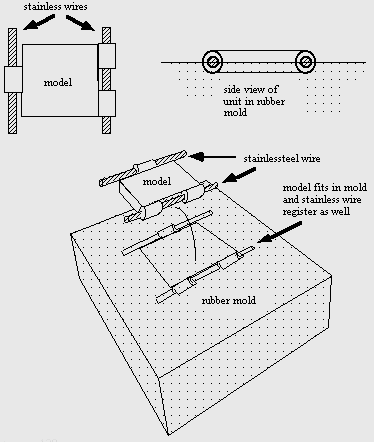Cast Hinges for Jewelers and Goldsmiths
Cast hinges are a very important part of much production jewelry work, partly because hinge assembly on such pieces is reduced to inserting the hinge pin and so provides a very fast linkage system ideal for cast objects. We are primarily speaking here of lost wax investment casting. If you look at any trade magazines you will find many examples of cast hinges in the advertisements.
3 Minute Read
Cast hinges are a very important part of much production jewelry work, partly because hinge assembly on such pieces is reduced to inserting the hinge pin and so provides a very fast linkage system ideal for cast objects.
We are primarily speaking here of lost wax investment casting. If you look at any trade magazines you will find many examples of cast hinges in the advertisements. I like the German magazines like Goldschmiede Zeitung(European Jeweller), Gold und Silber and Schmuck for this. Italian magazines, too, often have very good examples of cast hinges in the advertisements. The hinge units are built onto the model just as for a regular construction. The tube wall should be fairly thick to allow for shrinkage in the mold, in casting and during polishing. Shorter tubes or block hinges (1-3 mm in length) may be rubber molded without a second thought. Longer hinge knuckles should have a stainless steel wire core embedded in the mold to inject the wax around.
The model for a cast hinge is constructed carefully, accurately and with conscious planning for shrinkage and ease of finishing. Normally, in order to ensure a good wax model for a hinge, one has to make metal insert additions in the rubber mold that is injected with wax. One installs in the rubber mold a high-polished, stainless steel rod that lies where the hinge pin will lie in the final model, stuck through the tubing on the metal casting model when the mold is made and cut. The wire projects out of the ends of the hinge on the model. The wire then has built-in supporting grooves in the rubber mold, which allows the wax to flow around it thus producing a perfect, highly polished hole in the wax tube. It is thus anchored in the mold and registered.
One injects the wax around the polished steel rod in the rubber mold the wax model is taken out of the rubber mold, the steel rod is then pulled out of it, which results in wax tubes (hinge knuckles) with a high polished interior, ready for casting. The steel rod is then plugged back into its place in the mold for the next injection. The investment flows inside the hole in the wax knuckle and forms a core when casting usually the results are good.
As well, there are numerous plastic hinges available at the model shop, and even at the supermarket and pharmacy on small boxes and plastic objects, that can be burnt out and cast as-is and incorporated into jewelry. Hobby shops which specialize in radio-controlled airplanes have all kinds of polyethylene plastic hinges for flaps on the planes, in all sizes and thicknesses. Because polyethylene burns out well, such model airplane hinges can provide a source for hinges by casting.
Example
Here is an example of a hinged bracelet unit for cast reproduction. Notice how the bottom of the unit is hollowed out to reduce weight and to increase structural strength on the finished bracelet.
Other types of cast 'hinges' have a relationship to stud-and-peg systems as well as to tab ones. In the first example, a central unit joins two other ones the outer ones have rods which are dropped into slots on the central unit. Built-in tabs on each side of the slot are then pushed down with a punch, locking the outer units rods in place. From above, this can look like a machined hinge.
As in the previous example, many cast hinges are designed with the model made in an 'open' position so that after casting a unit can be inserted, and then the unit is closed onto studs so as to rapidly assemble the linkage system. Here is another example.
You assume all responsibility and risk for the use of the safety resources available on or through this web page. The International Gem Society LLC does not assume any liability for the materials, information and opinions provided on, or available through, this web page. No advice or information provided by this website shall create any warranty. Reliance on such advice, information or the content of this web page is solely at your own risk, including without limitation any safety guidelines, resources or precautions, or any other information related to safety that may be available on or through this web page. The International Gem Society LLC disclaims any liability for injury, death or damages resulting from the use thereof.
Charles Lewton-Brain
Master goldsmith Charles Lewton-Brain trained, studied and worked in Germany, Canada and the United States to learn the skills he uses. Charles Lewton-Brain is one of the original creators of Ganoksin.
The All-In-One Jewelry Making Solution At Your Fingertips
When you join the Ganoksin community, you get the tools you need to take your work to the next level.
Trusted Jewelry Making Information & Techniques
Sign up to receive the latest articles, techniques, and inspirations with our free newsletter.
